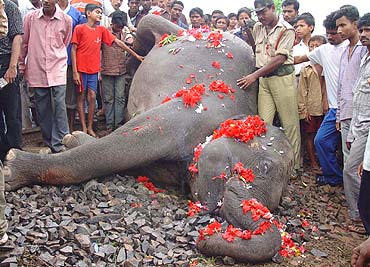|
| Mechanism to ease man-elephant conflict draws UK recongnition |
|---|
18-Mar-2010 : Courtesy : Assam Tribune
A simple, low-cost mechanism that is easing the man-elephant conflict in several villages
in Golaghat and Sonitpur districts has received international recognition from the
prestigious Darwin Initiative of the UK Government.
It is expected that more villagers will be able to live peacefully alongside elephants, thanks to the collaborative conservation endeavour, the Assam Haathi Project (AHP).
Conservationists from Chester Zoo and EcoSystems-India, who have been working together to mitigate the man-elephant conflict since 2004, have helped six affected villages and over 800 households in collaboration with local civil society organizations and the Forest Department. Significantly, no elephant or human death has occurred in these villages after interventions by the project and the local people.
The project uses simple, low-tech and low-cost measures, such as early warning trip-wires, chillies, spotlights and solar power fencing, to keep elephants away from crops and homes.
The project scientists and community members together collect information about movement and habits of elephant herds, to produce geographic information system (GIS) models with which we may predict future elephant movement and threats, AHP project manager, Nandita Hazarika of EcoSystems-India says, adding that the project also helps communities pursue alternative livelihoods such as cash crop cultivation and handicrafts, to diversify their income sources and offset the risk of loss to elephants. Among cash crops, cultivation of hot chillies is promoted as these fetch high returns and are also an effective deterrent to depredating herds of pachyderms.
The project has produced a practical handbook, Living with Elephants, in English and Assamese (Haati-Maanuhor Sahabasthaan Haatputhi) for the conflict-affected people in Assam and elsewhere.
The aim of the guide which includes tips on how to elephant-proof your home is to help villagers prevent elephant damage to their property and crops. The guide includes illustrated step-by-step directives on how to use chillies (super-hot bhot jalakia used in home-made chilli-fences or other pungent varieties in ‘chilli-smoke’) to deter elephants and explains how to build early warning systems (‘trip wires’) and watchtowers, Hazarika says.
It also describes how to set up and maintain a solar-powered electric fence. The handbook, which is being distributed to over 50 villages in Assam, contains advice on what not to do with raiding elephants: no throwing of objects, or using weapons or dogs to scare them.

Elephant shot dead in a tea garden of Assam - Courtesy Outlook India
|
According to Hazarika, the project has succeeded in improving the livelihoods of people and safety of elephants in six villages by training over 130 community members in Sonitpur and Goalpara districts. She, however, acknowledges the need to do more as there are many more villages in Assam which require help to cope with conflict incidents.
Alexandra Zimmermann, Chester Zoo Conservation Manager and AHP founder, says, Crop-raiding by elephants is not a new phenomenon, but with increasing rates of deforestation, elephants are forced to search for food and come into contact with farmers. The result is not only loss of crops, but also destruction of property and loss of human lives, and in turn, the killing of elephants. Our project combines community outreach with good science to bring the conflict under control and protect the lives of people and elephants.
The new recognition will allow the project to expand its work into new villages across other affected districts in the State. Together with the local communities and NGO partners we are striving to become a model for the resolution of the human-elephant conflict, Hazarika says.
|
|